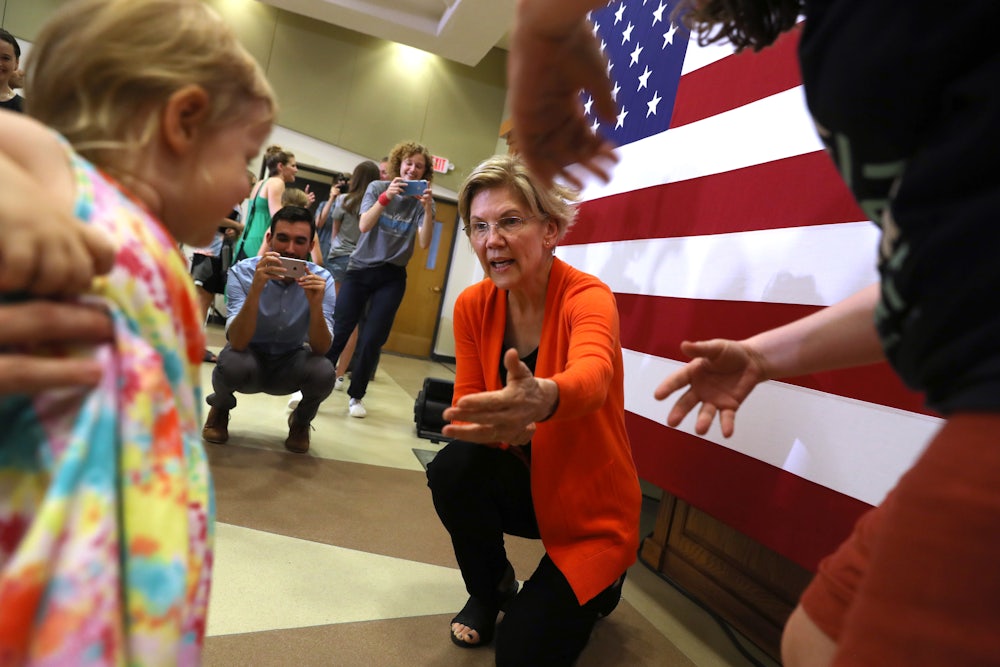Imagine if public K-12 education in America were no longer free, no longer a right. Parents would need to come up with tuition fees—an average of about $12,000 per child—or else figure out alternative arrangements. It would be chaos. Some parents would zero out their savings; others would leave the workforce to care for their children, or rely on family members to do so. A gray market of cheap, low-quality options would pop up. Parents would be gripped by stress, and the kids would suffer the most.
This is not an imaginary situation; it’s a reality for many families today, because child care is not a right. Yet even as this crisis has become national news, and Democratic candidates for president are offering competing solutions, the conversation still suffers from a lack of imagination. Even the boldest plans to address the problem don’t acknowledge what’s obvious to many Americans: Child care should not be simply “affordable.” It should be free and universal—a common good just like K-12 schooling.
The difference between a common good and a public assistance program is the difference between the nearly $700 billion a year America spends on universal K-12 education and the roughly $10 billion a year America spends on subsidizing child care for lower-income families (and still only reaching less than 15 percent of that population). Common goods—public schools, fire departments, roads, national defense—are those items which are so socially beneficial we don’t make the end user pay a dollar beyond their taxes. They are, instead, worthy recipients of what Thomas Jefferson called the “common expense.”
While recent proposals like the Child Care For Working Families Act and those put forth by candidates like Elizabeth Warren and Julian Castro are welcome, they all implicitly keep child care in the realm of public assistance. These proposals utilize the U.S. Department of Health and Human Services’ line of 7 percent of family income to define “affordable” child care (albeit with a sliding scale, so some lower-income families would pay nothing). Yet no one pays a maximum of 7 percent of their income to send their child to fourth grade, nor are there sliding scale fees for getting the fire department to come to one’s house. Accepting the premise that child care is ultimately a private burden keeps the sector stuck where it’s been for far too long—in what historian Sonya Michel calls “the shadows of charity.”
It’s perhaps understandable why child care was not considered a common good a half-century ago, when more than half of mothers didn’t work. But today, two-thirds of children have all available parents in the workforce, meaning they require some amount of outside care. For all but the most affluent, modern families cannot sustainably absorb the costs of care without major disruption to their ability to contribute economically. Our grasp of early childhood development has taken a quantum leap, and we now know the extent to which brain development is influenced by high-quality early experiences as well as family financial stability. Most importantly, our society’s ideas about mothers getting to choose whether they work outside the home—though still a source of ambivalence—have undeniably evolved.
While some may caution a stepwise approach, the philosophical shift in the way we talk and think about the birth-to-five years is a necessary precursor to any major policy moves. Last year’s doubling of federal subsidization of child care was hailed as historic, which is true, yet that increase was a mere $5.8 billion over two years. What’s more, being a public assistance program leads to hard-fought gains becoming precarious; already, there’s concern that the increased federal funding may be clawed back by the Senate.
The type of public money required to craft a universal, free, high-quality early childhood system—one that pays practitioners middle-class salaries and also compensates stay-at-home parents—is going to run in the hundreds of billions per year. As a question of funding charity or welfare, that figure sounds absurd. As a question of funding a common good akin to K-12 education, the absurdity is that we spend a dismal fraction on the childhood years that may matter the most for educational outcomes. (The universality of this child care proposal is critical: Even though the wealthy benefit from services they could easily afford, the lack of a means test is the engine of a common good.)
There is plenty to debate regarding the best design for America’s child care system. Early childhood is a developmentally distinct period from middle childhood and adolescence, and research is clear that the setting in which early care is delivered matters far less than the quality of caregiver-child interactions. There are no easy answers in a sector where care is variously delivered by parents, relatives, home-based providers, religious providers, center-based providers, and school districts, to say nothing of state and federal programs and regulations.
The question of how to pay for a new right to early care and education also looms large. There’s no lack of progressive options on the table, ranging from Warren’s wealth tax to a financial transaction tax to taxing corporations. Whatever the right mix of revenue streams, the larger point is that when America decides something is a common good, we find the funding. What’s more, places from Quebec to Washington, D.C. have shown that policies similar to universal child care have a near-immediate return on investment due to spikes in parental employment.
Even as Republicans push to privatize public education, few Americans believe that parents should have to pay for K-12 out of their pockets. But this wasn’t always true. As a recent Bipartisan Policy Center paper points out, “free universal primary and secondary education was itself a revolutionary concept when the United States introduced it in the early 1800s.” Free universal child care may seem revolutionary today, but there is no viable solution to America’s child care crisis that doesn’t start with a tremendous new public investment in the early years. Until then, we’re mostly arguing over paint swatches while the house crumbles.
